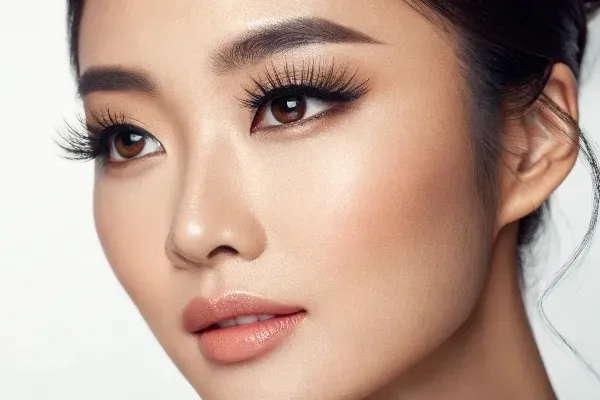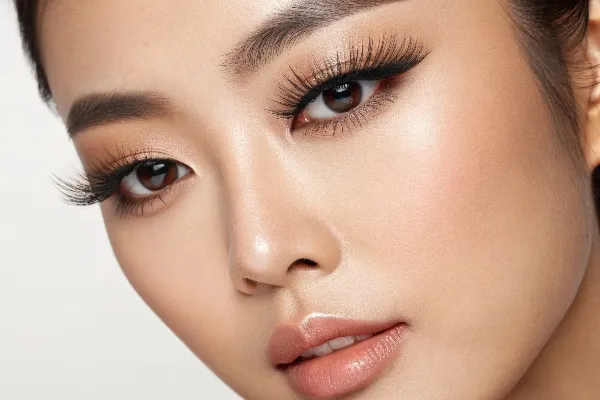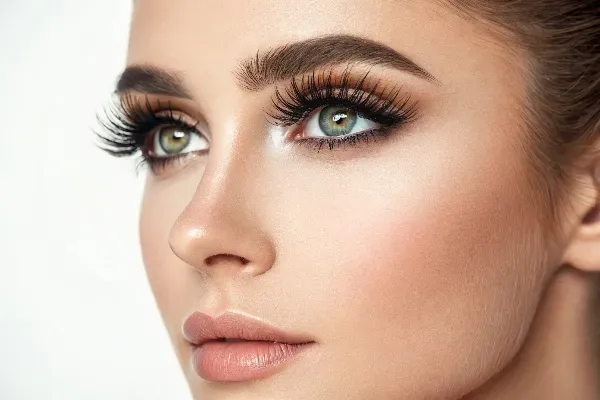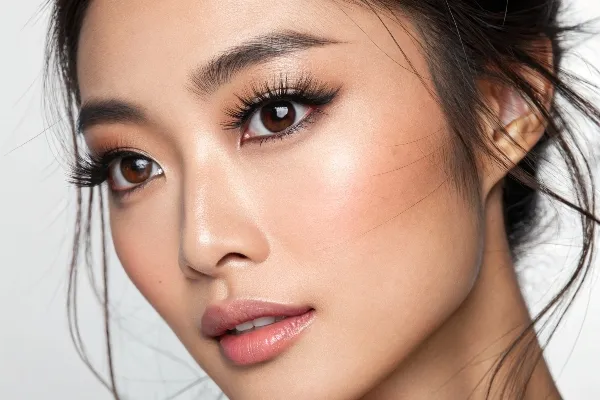J'hésite parfois à choisir des extensions de cils parce que je suis préoccupée par l'éthique et le bien-être des animaux. Je voudrais savoir s'il existe des extensions de cils végétaliennes et comment elles se comparent aux options traditionnelles.
Oui, il existe des extensions de cils végétaliennes, fabriquées à partir de fibres synthétiques sans matériaux d'origine animale. Elles constituent un moyen exempt de cruauté de rehausser vos cils tout en restant en phase avec les préoccupations éthiques.

Je trouve que les cils végétaliens me permettent de profiter de beaux cils bien fournis sans me soucier de l'origine des matériaux. Explorons les extensions de cils les plus naturelles, si les cils russes sont végétaliens, comment sont fabriqués les cils sans cruauté et si les extensions de cils abîment les cils naturels.
Il m'arrive de vouloir des extensions de cils qui soient à la fois subtiles et flatteuses. Je crains que les extensions ne paraissent trop dramatiques ou artificielles si je choisis le mauvais style.
Les plus extensions de cils naturels1 sont généralement des ensembles classiques fabriqués à partir de fibres légères qui reproduisent fidèlement la longueur et la courbure naturelles de vos cils. Ils se fondent parfaitement dans la masse et offrent un effet liftant crédible.

La question se pose souvent de savoir quel style de cils donne la finition la plus naturelle. D'après mon expérience, les extensions classiques offrent souvent la meilleure amélioration discrète. Une extension est appliquée sur chacun de vos cils naturels, créant une augmentation subtile de la longueur et de l'épaisseur sans paraître trop dense. Les fibres utilisées peuvent également déterminer le degré d'authenticité du résultat, surtout si elles ont une forme douce et reproduisent la silhouette des vrais cils.
Certaines personnes pensent que les extensions de volume ne sont pas naturelles, mais ce n'est pas toujours le cas. Les techniques de volume consistent à appliquer plusieurs extensions ultrafines sur un cil naturel, formant ainsi un éventail. Si le créateur de cils utilise des fibres très légères et fines et des éventails plus petits, comme dans le cas d'un kit 2D ou 3D, le résultat peut rester doux et crédible. Cependant, les kits classiques restent souvent la solution pour celles qui recherchent le look le plus subtil.
Le choix d'un type de courbure approprié est également important. Une courbure modérée, telle qu'une courbure en C, ressemble beaucoup à la courbure naturelle des cils et évite l'effet trop spectaculaire que l'on peut observer avec une courbure en D ou en L. La longueur des extensions doit correspondre à celle de vos cils ou être supérieure d'un millimètre ou deux, afin que les extensions aient l'air réelles. Une longueur trop importante peut faire pencher la balance et donner l'impression que les extensions sont artificielles.
La qualité de l'adhésif et le processus d'application influent également sur le résultat. Un créateur de cils professionnel isole soigneusement chaque cil afin d'éviter la formation de paquets ou de liaisons croisées. Cette méthode méticuleuse permet de conserver une apparence douce et ondulante qui s'aligne parfaitement sur le modèle de croissance naturel des cils.
Parfois, la différence entre un résultat naturel et un résultat exagéré réside dans de petits détails. Des cils espacés de manière régulière et qui s'étalent en éventail avec une pointe délicate reflètent une véritable croissance des cils. L'épaisseur de chaque extension a également son importance. Je préfère un diamètre plus fin, comme 0,10-0,15 mm, pour un ensemble classique si je vise un style très naturel. Les diamètres plus épais peuvent donner l'impression que l'ensemble est plus lourd que prévu.
Enfin, le choix de la fibre influe sur la sensation et l'apparence générales. Les fibres de soie ou de faux vison, en particulier les fibres synthétiques de haute qualité, imitent souvent la brillance et la douceur des vrais cils. En combinant une augmentation subtile de la longueur, une courbure douce et la bonne technique d'application, ces matériaux produisent un effet final qui est presque impossible à distinguer des cils naturels.
Je vois souvent parler de "volume russe" lorsque je consulte les options de cils. Je me demande si ces kits spécialisés peuvent être végétaliens ou s'ils utilisent toujours de la fourrure animale.
Cils russes2 peuvent être végétaliens s'ils utilisent des fibres synthétiques de haute qualité. Le terme "russe" fait référence à la technique de volume, et non au matériau des cils lui-même.

L'expression "cils russes" décrit généralement une méthode basée sur le volume plutôt que la composition des cils eux-mêmes. Le volume russe consiste à créer de petits éventails de plusieurs extensions fines - allant de 2D à 5D ou plus - et à les appliquer sur un seul cil naturel. Ce style permet d'obtenir un aspect plus fourni et plus pelucheux que les extensions classiques.
Historiquement, certains cils volumineux, en particulier les "cils en vison", utilisaient de la vraie fourrure de vison. La fourrure de vison n'est ni végétalienne ni exempte de cruauté. Cependant, de nombreux artistes des cils préfèrent aujourd'hui des matériaux synthétiques comme le faux vison pour le volume russe. Le faux vison imite la douceur et la légèreté de la vraie fourrure, mais sans utiliser d'animaux. Cette approche est non seulement plus éthique, mais aussi plus hygiénique. La fourrure de vison peut être porteuse d'allergènes et ne conserve pas ses boucles de manière aussi fiable lorsqu'elle est exposée à l'humidité ou aux huiles.
Si vous tenez à un mode de vie végétalien, vous devez vous assurer que votre artiste des cils utilise des fibres synthétiques ou végétales. Certaines fibres synthétiques avancées combinent un poids plume avec une conicité réaliste, ce qui les rend idéales pour les éventails volumineux. Le diamètre des cils pour les ensembles russes peut être aussi fin que 0,03 mm ou 0,07 mm, ce qui permet aux éventails de rester légers et de ne pas exercer de tension sur vos cils naturels.
Étant donné que le terme "russe" fait principalement référence à la manière dont les éventails sont créés, vous pouvez tout à fait avoir des cils russes végétaliens, à condition que la marque de cils que vous choisissez produise des fibres synthétiques sans cruauté. De nombreux fournisseurs de cils se spécialisent désormais dans les options végétaliennes. En vérifiant les matériaux auprès de votre technicienne ou de votre fournisseur, vous vous assurez que le produit final est conforme à votre position éthique.
Il convient également de noter qu'une application correcte est essentielle. Même les cils russes végétaliens peuvent endommager les cils naturels s'ils ne sont pas appliqués avec soin. Un créateur de cils expérimenté placera ces éventails correctement, en veillant à ce qu'ils ne surchargent pas vos cils naturels et qu'ils ne s'agglutinent pas. Avec les bons matériaux et la bonne technique, les cils russes peuvent être à la fois végétaliens et étonnamment fournis.
Je me sens parfois mal à l'aise à l'idée de porter des cils issus d'animaux ou de pratiques non éthiques. J'aimerais savoir ce que les cils sans cruauté utilisent à la place.
Cils sans cruauté sont généralement fabriqués à partir de fibres synthétiques telles que faux vison1 ou de la soie, ce qui élimine la nécessité d'utiliser de la vraie fourrure animale et réduit les dommages causés aux animaux.

Les cils sans cruauté reposent sur des méthodes de fabrication qui n'exploitent pas les animaux et ne leur font pas de mal. La véritable fourrure de vison, par exemple, provient de visons d'élevage. Bien que certaines marques affirment que la fourrure est recueillie lors de la mue, des questions subsistent quant au bien-être des animaux. C'est pourquoi l'industrie de la beauté a adopté des alternatives synthétiques qui reproduisent la douceur du vison sans impliquer d'animaux.
Le faux vison est l'une des options sans cruauté les plus populaires. Il est fabriqué à partir d'un mélange de fines fibres synthétiques qui imitent la nature aérée et légère du vison véritable. Ces fibres ont souvent une pointe effilée et une finition légèrement brillante, ce qui leur confère un aspect similaire à celui de la fourrure véritable. La qualité des faux cils en vison peut varier, c'est pourquoi je recherche généralement des fournisseurs bien notés qui mettent l'accent sur la douceur et la durabilité.
Les cils en soie, malgré leur nom, ne sont généralement pas fabriqués à partir de véritables vers à soie. Beaucoup sont des mélanges synthétiques qui reproduisent la brillance et l'épaisseur souvent associées à la soie. Ils ont tendance à être un peu plus brillants que les faux visons, ce qui en fait une bonne option si vous souhaitez une apparence un peu plus audacieuse. Cependant, tous les cils en soie ne sont pas exempts de cruauté par défaut, il est donc important de vérifier les allégations de la marque concernant les matériaux.
Certaines marques sans cruauté utilisent également des fibres végétales, telles que celles dérivées du bambou ou du coton. Bien que moins courantes, ces matières peuvent être biodégradables ou plus durables. Elles n'ont peut-être pas exactement la même finition que le vison synthétique ou la soie, mais elles peuvent néanmoins offrir un aspect doux et attrayant.
Voici une brève comparaison des matériaux pour cils sans cruauté les plus courants :
| Matériau | Apparence | Poids/Sens | Remarques |
|---|---|---|---|
| Faux vison | Doux, plumeux | Léger | Imite la vraie fourrure de vison |
| Soie synthétique | Légèrement plus brillant | Léger à moyen | Offre une brillance subtile |
| Bambou/Coton | Mat à légèrement brillant | Variable | Respectueux de l'environnement, moins courant |
Un autre point essentiel est la colle. Si vous souhaitez adopter une routine éthique, vous pouvez vérifier si la colle est exempte de certains dérivés d'origine animale. La plupart des colles à cils modernes sont synthétiques, mais il est bon de vérifier. En choisissant des matériaux et des adhésifs sans cruauté, vous pouvez porter des cils en sachant qu'aucun animal n'a été blessé au cours du processus.
J'entends parfois des rumeurs selon lesquelles les extensions de cils abîment les vrais cils. Cela m'inquiète, mais j'aime aussi le côté pratique des extensions.
Les extensions de cils ne détruisent pas les cils naturels lorsqu'elles sont appliquées correctement et entretenues. Une mauvaise technique ou une négligence peut entraîner des dommages, mais une utilisation prudente permet de conserver des cils en bonne santé.
Pour préserver la santé de vos cils naturels tout en profitant des extensions, il faut adopter la bonne approche. Les extensions peuvent être sûres si vous choisissez un artiste des cils compétent qui pratique une bonne hygiène et utilise des matériaux de haute qualité. Les problèmes courants tels que la chute prématurée ou la cassure des cils surviennent souvent lorsque les artistes appliquent les extensions de manière incorrecte ou lorsque les clientes ignorent les consignes d'entretien.
Premièrement, isolation correcte de chaque cil3 est essentielle. Si plusieurs cils naturels sont collés les uns aux autres, cela peut provoquer des tensions et une chute inégale. Un artiste qualifié séparera chaque cil et ne fixera qu'une extension (ou un éventail dans le cas d'un volume) par cil naturel, afin que chaque poil puisse pousser et tomber indépendamment.
Deuxièmement, il est essentiel de choisir des longueurs et des épaisseurs adaptées. Une extension de cils trop lourde risque d'exercer une pression sur les cils les plus faibles et de les faire tomber prématurément. Par exemple, si vos cils sont fins, le choix d'une extension méga-volume risque de les stresser. J'aime choisir des diamètres et des longueurs qui correspondent à la force naturelle de mes cils. Cela permet de les garder en bonne santé pendant plusieurs cycles d'extension.
Troisièmement, les soins après-vente jouent un rôle important. L'utilisation de démaquillants et de nettoyants sans huile est indispensable. L'huile peut affaiblir le lien adhésif et provoquer le relâchement des extensions. J'évite également de frotter ou de tirer sur mes yeux et je les tapote toujours délicatement lorsque je me sèche le visage. Les brosses à cils permettent de démêler les extensions et d'éviter qu'elles ne s'accrochent. En adoptant ces habitudes simples, je maintiens les extensions et les cils naturels en bon état.
Quatrièmement, il peut être utile de prévoir des pauses périodiques. Certaines personnes préfèrent prendre des "vacances" après plusieurs mois de port continu. Cela permet aux cils naturels de se reposer. Toutefois, cela n'est pas strictement nécessaire si vous utilisez des extensions bien adaptées et si vous pratiquez un bon entretien. De nombreuses personnes conservent leurs extensions pendant des années sans problème.
Enfin, il est important de retirer les extensions de la bonne manière. Si vous tentez de les retirer à la maison, vous risquez d'arracher les cils naturels. Je recommande plutôt de retourner au salon ou d'utiliser un dissolvant professionnel qui assouplit l'adhésif. Cela permet d'endommager le moins possible la ligne des cils. En résumé, les extensions de cils ne deviennent destructrices que lorsqu'elles sont mal appliquées ou mal entretenues. Avec une technique appropriée et un entretien régulier, elles peuvent rehausser votre apparence sans endommager vos vrais cils.
Extensions de cils végétaliennes offrent un moyen sans cruauté de mettre en valeur vos yeux, que vous préfériez un style naturel ou un effet plein de volume. En choisissant des matériaux synthétiques et en les entretenant correctement, vous pouvez profiter de cils magnifiques sans compromettre vos valeurs ou la santé de vos cils naturels.
Explorez ce lien pour découvrir les meilleures options d'extensions de cils naturels qui rehaussent votre beauté sans paraître artificielles. ↩ ↩
Explorez ce lien pour comprendre les matériaux utilisés dans les cils russes et comment ils peuvent être respectueux de l'environnement. ↩
Apprenez l'importance de l'isolation des cils pour prévenir les dommages et garantir des cils naturels sains. ↩